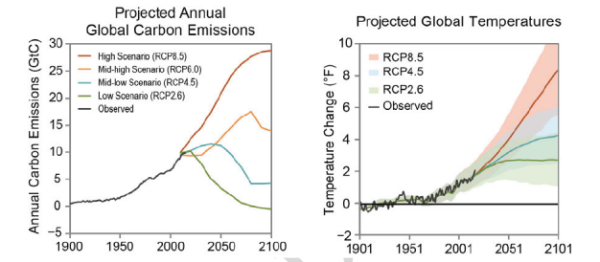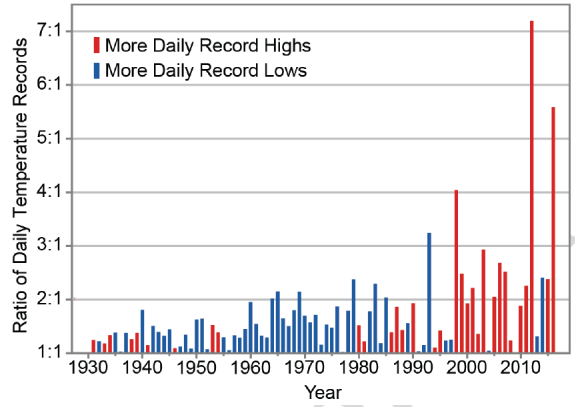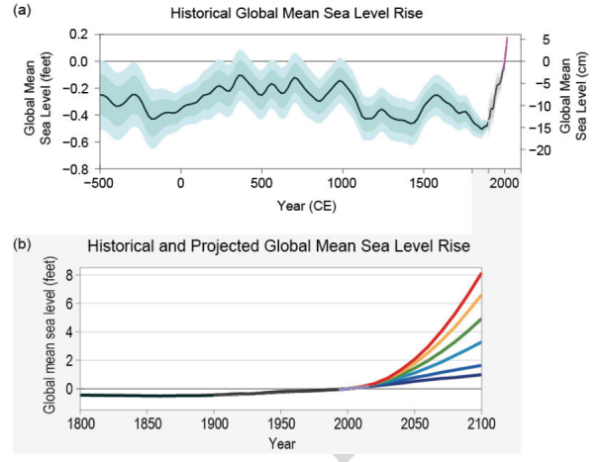Robertscribbler is putting a lot of emphasis on a report that was leaked to the NY Times to bypass Trump.
He
says that this is the report Trump doesn’t want you to see.
Well,
Robertscribbler doesn’t want you to see a report that is much more
significant than the one he refers to -
'Dodgy' greenhouse gas data threatens Paris accord
What
he doesn’t want you to know (and the BBC was willing to report) is:
"Air
monitors in Switzerland have detected large quantities of one gas
coming from a location in Italy.
"However,
the Italian submission to the UN records just a tiny amount of the
substance being emitted.
"These
flaws posed a bigger threat to the Paris climate agreement than US
President Donald Trump's intention to withdraw, researchers told BBC
Radio 4's Counting
Carbon programme."
Denying the Storm: Climate Change Report Findings the Trump Administration Doesn’t Want You to Know About
8
August, 2017
Yesterday, the
New York Times published the final draft of a broad-based U.S.
climate change report.
And given the fact that the Trump Administration, brimming with
politically-contrived climate change denial, is still pushing full
steam toward a reckless withdraw from the Paris Climate Summit, we’re
pretty confident that it’s hot information they don’t want you to
get your hands on.
The
report carries with it a monumental scientific gravitas. A level of
credibility that Trump, even in his wildest fantasies, couldn’t
hope to achieve. It includes a culmination of research coming
from thousands
of peer-reviewed studies resulting in the accumulated work of tens of
thousands of scientists.
The National
Oceanic and Atmospheric Administration (NOAA)
served as the lead government agency conducting the report.
Representatives from three other federal agencies joined with NOAA
along with a team of 54 scientist authors and reviewers drawing from
both public and private sector institutional knowledge in compiling
the report.
The
673 page report represents
a massive body of the latest scientific findings on climate change.
It includes numerous key advances in understanding which we will take
a shot at briefly highlighting for you here.
Humans
Are the Primary Cause of Warming by a Huge Margin
The
key finding of the report is that humans are causing the Earth to
warm very rapidly. The study noted a 95 to 100 percent likelihood
that human activity produced the approximate 0.85 C warming since the
mid 20th Century and the 0.7 C warming since 1986. For the U.S.,the
report finds that recent decades have been warmer than any time
within the last 1500 years.
Meanwhile, it forecasts that future decades will at least be the
warmest experienced in tens of thousands to millions of years.
(Tens
of thousands of climate scientists agree — the considerable warming
trend we’ve seen since the 1880s has been caused by human
emissions. Image source: Climate
Report.)
The
report goes on to state that there is no
convincing line of scientific evidence that provides a cause for this
warming other than human emissions.
That the increasingly accurate observations of solar and volcanic
activity reveal only very minor nudges to the climate system compared
to the vast heat-trapping influence of human-emitted greenhouse
gasses. Meanwhile, though natural variability influences like El Nino
and La Nina have effects on climate over months and years, the global
impact of these natural sources greatly diminish over the course of
the decades long warming regime that is now well established.
Future
Warming is Locked in, But it Can be Dramatically Reduced by Cutting
Carbon Emissions
Overall,
the future isn’t looking too good. Because of past and current
human emissions (coal, oil, and gas burning), the report finds that
global climate change is projected to
continue throughout this Century and beyond.
Rapid cuts to greenhouse gas emissions, according to the study, were
needed to have a chance of limiting warming to 2 C this Century. But
the study found that even an immediate stabilization at present
levels of atmospheric greenhouse gasses by ceasing present emissions
would result in 0.6 C additional warming compared to recent decades.
Longer term, the study points to a necessity that atmospheric CO2,
methane, and other greenhouse gasses fall below present levels to
meet the goals of preventing 2 C warming over the long term.
Continued
emissions result in considerably more warming, according
to the study, with temperatures hitting as high as 5 C or more above
1901 to 1960 averages if policies like Trump’s result in renewed
increases in fossil fuel burning. What this means is that we can
considerably limit the amount of damage caused by human-forced
climate change if we rapidly cut emissions in the near term. But if
we fail to do that, and Trump is leading us down this more dangerous
path by killing the Clean Power Plan and backing out of the Paris
Climate Summit, then temperatures will rise into extraordinarily hot
and harmful ranges.
The
study finds with high confidence that we presently remain on the
higher emissions scenario pathways excepting a pause in emissions
increases during 2014 and 2015. The
study also finds that present rates of greenhouse gas emissions
reductions are not yet in line with the goals of the Paris Climate
Accord.
Extreme
Weather is Becoming More Common and More Attributable to Human Caused
Climate Change
Perhaps
the most important new takeaway from the report is a developing
clearer view of the impact of present warming on severe weather
events. The report finds that many
temperature and precipitation extremes are becoming more common.
That the number of high temperature records over the past twenty
years greatly
exceeds the number of low temperature records.
And that heavy precipitation events have
increased in both frequency and intensity.
Much evidence has been found for a human-caused influence on soil
moisture deficits due to evaporation that leads to more rapid drought
intensification. And the incidence of large fires in the Western
United States has increased significantly since the 1980s and is
expected to increase further.
The
study also finds that Northern Hemisphere snow cover and water held
in snow has declined. That there has been a decrease in snowstorm
frequency along the southern margins of snowy areas. That the Arctic
is losing more than 3.5 percent of its sea ice coverage every decade
and that September sea ice extent is declining by more than 10
percent per decade. That Arctic land ice losses are also
accelerating. It notes a contested
scientific linkage between the increased severity of winter storms
and a rapid observed warming in the Arctic.
The study also identifies changes in tornado frequency and notes a
possible linkage between thunderstorm wind intensity, increased
convection, hail and climate change. Moreover, the study finds a
global intensification of thunderstorms overall as the world has
warmed. Tropical cyclone peak intensity is expected to ramp up even
as typical cyclone formation regimes are altered.
Perhaps
more disturbing is the fact that the study identifies an emerging
understanding that human-caused climate change is starting to affect
larger natural variability based systems like El Nino, the North
Atlantic Oscillation, the North Pacific Oscillation, the Pacific
North American Pattern, the Jet Stream, the size of the Tropics,
atmospheric circulation patterns, rivers of moisture and storm tracks
to varying degrees and with varying degrees of certainty or
uncertainty.
These systems not only play a major role in present
global weather patterns, but our understanding of how they operate is
also critical to our ability to predict weather. So climate change
based alterations in these larger systems creates higher levels of
uncertainty with regards to extreme weather risks.
The
key takeaway of all this being that:
Some extremes have already become more frequent, intense, or of longer duration, and many extremes are expected to increase or worsen, presenting substantial challenges for built, agricultural, and natural systems.
Harmful
Impacts to Oceans are on the Rise
Oceans,
another key aspect of the health of the Earth’s life support
system, according to the study, are warming, rising, becoming more
acidic, and risk becoming stratified as they lose oxygen.
The
study found that the oceans have absorbed 93
percent of the excess heat produced by human greenhouse gas
emissions.
That this added heat is having a number of serious effects. For one,
the rate of sea level rise was found to be faster than at any time in
the past 2,800 years. That end Century projections for sea level rise
are heavily dependent on future emissions and range from 1 to 8 feet
in the study.
The
study finds that even present rates of sea level rise have resulted
in significant increases in the incidence of coastal flooding. That
tidal flooding events has multiplied by 5-10 times the rate observed
in the 1960s overall and that the vulnerable Atlantic and Gulf coasts
have seen an increase in tidal flooding that is now 25 times times
1960s values due to warming-related sea level rise. As sea level rise
accelerates this Century, flooding is expected to considerably worsen
— with
the most damaging effects happening alongside the highest levels of
possible future greenhouse gas emissions.
The study also identified potentially compounding effects from
possibly worsening Atlantic storms and heavier coastal rainfall
events.
Ocean
warming and increasing glacial outflows also have a potential to
effect ocean overturning circulation in the upper middle latitudes.
Of particular interest is the possible disruption of the Atlantic
Meridional Overturning Circulation (AMOC) this Century. Recent
unconfirmed scientific observation has already pointed to some
impacts to AMOC due to warming during recent years. But the report
notes that it is presently difficult to validate these observations.
Disruption to AMOC would have a considerable impact on North Atlantic
weather patterns. It would also reduce both ocean carbon and heat
uptake due to a more stratified and less well mixed ocean system. The
study identifies a weakening of AMOC of between 12 and 54 percent
under worst-case greenhouse gas emissions scenarios.
As
risks of ocean stratification mount, acidification of the world’s
waters is rapidly increasing. Atmospheric carbon dioxide rising above
400 parts per million was found to worsen detrimental effects by
increasing ocean acidity levels. The
study found that the rate of ocean acidification increase was
unparalleled in the past 66 million years at least.
That higher rates of fossil fuel burning and greenhouse gas emissions
would result in another doubling or more of ocean acidity by the end
of this Century.
Heating,
stratifying, and more acidic oceans are also steadily losing oxygen.
The study finds that the amount of oxygen held in the oceans is
falling coincident with warming. The study identifies a declining
ocean oxygen content at intermediate depths and major losses in
oxygen in inland seas, estuaries, along coasts, and in parts of the
open ocean. Lower oxygen means more ocean dead zones and more toxic
anaerobic microbial blooms. Overall ocean oxygen content is expected
to fall by 3.5 percent under worst case warming and fossil fuel
emissions scenarios by 2100.
Serious
Risk of Unanticipated Changes
The
level of evidence provided by the study that humans are changing the
climate and that these changes are increasingly harmful is
mountainous. And this base fact alone is reason enough for a climate
change denying Trump Administration to try and bury its findings. But
it is perhaps the study’s own admitted uncertainty over future
risks that reveals how reckless Trump’s combined denial of climate
change and doubling down on fossil fuel based emissions has
ultimately become.
The
study itself is based on physical model and consensus science
findings.
This lends weight to the evidence it has provided in that it is
highly qualified. However, the study responsibly indicates the
potential weak points of model based consensus studies. Models are
notably less able to duplicate higher paleoclimate levels of warming
— indicating
an increased likelihood that rates of warming will be more intense
than expected and a reduced likelihood that warming will be less
intense than expected.
The study also cautions that there is another limitation to the
ultimate accuracy of model predictions in that models themselves are
unable to capture what it calls critical
threshold and compound
events.
Compound
events are
described as multiple extreme climate change events occurring at the
same time to generate an unanticipated level of harmful disruption. A
good example of a compound event is extreme heat risking injury or
loss of life, extreme drought harming crops and water supplies in the
same region, and both coinciding with a severe or unprecedented
wildfire outbreak. Critical
threshold events occur
when the climate system crosses a tipping point and then radically
adjusts to a new climate state. A worrisome critical threshold event
is crossing a tipping point in which significant carbon feedbacks
from the Earth System occur — locking in more extreme warming and
generating periods in which global temperatures more rapidly spike.
Both of these kinds of events have the potential to produce
consequences that are difficult or impossible to manage. And the
chance of such catastrophic events occurring increases along with
higher rates of fossil fuel burning and coinciding higher levels of
warming.
The
precautionary principle alone demands that we do our best to avoid
increasing these uncertain risks even as we steer away from the much
more certain harms like sea level rise and generally increasing
extreme weather. The science has again given us a more clear, more
refined, gift in
the form of this very valuable provision of foresight.
And yet the current U.S. executive leadership is bound and determined
to obstinately ignore or it, cast doubt on it, and do everything
possible to cloud the clear and priceless message being sent to us by
an army of selfless and dedicated climate researchers.
Links:
Images
taken directly from the report
Hat
tip to Greg
Hat
tip to Wili
Scientists "Are Screaming From the Mountaintops That We’re in a Dire Situation"
Humptydumptytribe









No comments:
Post a Comment
Note: only a member of this blog may post a comment.